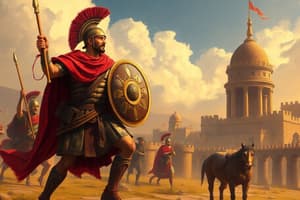Podcast
Questions and Answers
¿Cuál de las siguientes ciudades NO era parte de Hispania bajo el dominio romano?
¿Cuál de las siguientes ciudades NO era parte de Hispania bajo el dominio romano?
- Toletum
- Roma (correct)
- Tarraco
- Cordoba
El reino visigodo en Hispania fue un gobierno unificado y estable durante toda su existencia.
El reino visigodo en Hispania fue un gobierno unificado y estable durante toda su existencia.
False (B)
¿Cuál es el nombre del código legal visigodo que codificó muchos aspectos de su sociedad?
¿Cuál es el nombre del código legal visigodo que codificó muchos aspectos de su sociedad?
Liber Iudiciorum
El período islámico en la Península Ibérica se conoce como ______.
El período islámico en la Península Ibérica se conoce como ______.
Empareja los siguientes términos con sus descripciones correctas:
Empareja los siguientes términos con sus descripciones correctas:
Flashcards
Hispania
Hispania
Nombre romano para la Península Ibérica, hoy España y Portugal.
Romanización
Romanización
Difusión de lengua, leyes y prácticas romanas en Hispania.
Reino Visigodo
Reino Visigodo
Reino establecido por los visigodos tras la caída del Imperio Romano.
Liber Iudiciorum
Liber Iudiciorum
Signup and view all the flashcards
Al-Ándalus
Al-Ándalus
Signup and view all the flashcards
Reconquista
Reconquista
Signup and view all the flashcards
Los Reyes Católicos
Los Reyes Católicos
Signup and view all the flashcards
Descubrimiento de América
Descubrimiento de América
Signup and view all the flashcards
Study Notes
Hispania
- Hispania was the Roman name for the Iberian Peninsula, encompassing modern Spain and Portugal.
- Roman rule profoundly influenced Iberian Peninsula's culture, infrastructure, and legal systems.
- Romanization involved the spread of Latin language, Roman law, and administrative practices.
- The region saw substantial urban development, featuring amphitheaters, aqueducts, and other public works.
Visigothic Kingdom
- After the fall of the Western Roman Empire, the Visigoths established a kingdom in Hispania.
- The Visigothic kingdom endured for centuries, leaving a lasting legacy on law and social structures.
- Visigothic legal codes, notably the Liber Iudiciorum, codified many aspects of Visigothic society.
- The Visigothic kingdom experienced periods of internal conflict and external pressures.
Al-Ándalus
- Al-Ándalus represented the Islamic period in the Iberian Peninsula.
- Muslim rule commenced in the early 8th century CE and lasted nearly eight centuries.
- Al-Ándalus served as a hub for intellectual and cultural exchange, fostering advancements in science, medicine, and art.
- The region witnessed the construction of magnificent mosques, palaces, and sophisticated irrigation systems.
- Al-Andalus's dynamic society experienced various periods and shifts in power.
- The Reconquista marked the gradual Christian reconquest of the Iberian Peninsula from Muslim rule.
Reconquista
- The Reconquista was a lengthy and intricate process, characterized by periods of conflict and relative peace.
- The Reconquista involved the gradual northward Christian advance over Al-Andalus.
- Regional kingdoms, such as Castile and Aragon, played crucial roles in the Reconquista.
- Christian kingdoms frequently engaged in alliances and conflicts among themselves during this period.
The Catholic Monarchs (Reyes Católicos)
- Ferdinand and Isabella, the Catholic Monarchs, united most of the Iberian Peninsula under their rule.
- The 1469 marriage of Ferdinand and Isabella was a significant step towards the unification of Spain.
- The Catholic Monarchs strengthened royal power and established a robust centralized state.
- Their policies supported the Spanish Inquisition, a religious court established to enforce religious conformity.
Discovery of America
- The voyages of Christopher Columbus, sponsored by the Catholic Monarchs, led to the European discovery of the Americas.
- The 1492 discovery of America had profound consequences for both the Old World (Europe) and the New World (Americas).
- This event was a pivotal moment in global history, resulting in significant and lasting cultural, social, political, and economic transformations.
- The arrival of Europeans in the Americas triggered the transatlantic exchange of goods, plants, animals, and diseases.
Studying That Suits You
Use AI to generate personalized quizzes and flashcards to suit your learning preferences.




